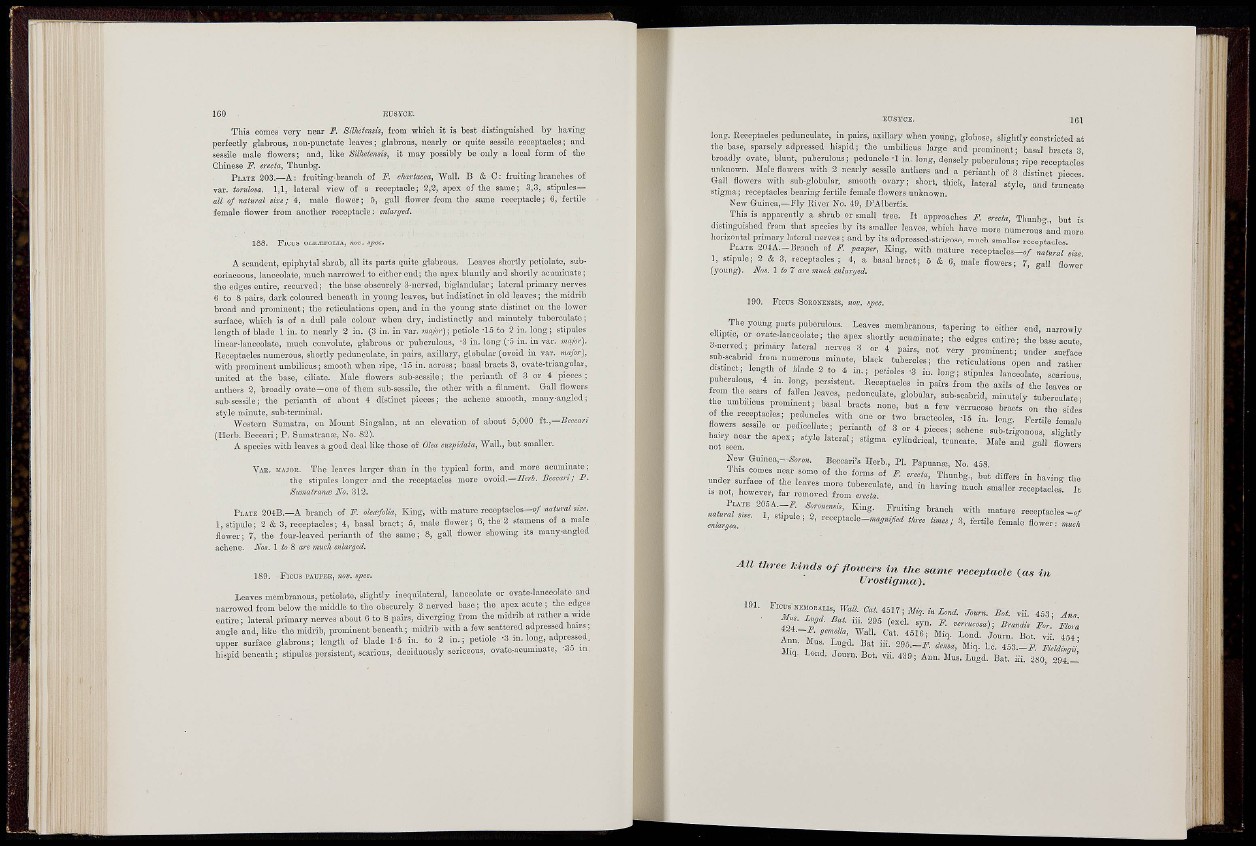
This comes very near F. Silheiensis, from which it is "best diatiuguished by having
perfectly glabrous, non-punctate leaves; glabrous, nearly or quite sessile receptacles; and
sessile male flowers; and, like Silhctensis, it may possibly be ouly a local form of the
Chinese F. erecta, Thunbg.
PLATE 203.—A: fruiting-branch of F. chartacea, Wall. B & C: fruiting branches of
var. torulosa. 1,1, lateral view of a reccptacle; 2,3, apex of the same; 8,3, stipules—
all of natural size; 4, male flower; 5, gall flower from the same reccptacle; 6, fertile
female flower from another receptacle; enlarged.
188. Ficus OLEIEFOLIA, nov. spec.
A scandent, epiphytal shrub, all its parts quite glabrous. Leaves shortly petiolate, subcoriaceous,
lanceolate, much narrowed to either end; the apex bluntly and shortly acuminate;
the edges entire, recurved; the base obscurely 3-nerved, bigkndular; lateral primary nerves
6 to 8 pairs, dark coloui-ed beneath in young leaves, but indistiuct iu old leaves; the midrib
broad and prominent; the reticulations open, and in the young state distinct on the lower
surface, which is of a dull pale colour when dry, indistinctly and minutely tuherculate;
length of blade 1 in. to nearly 2 in. (3 in. in var. ma/w); petiole -15 to ? in. long; stipules
linear-lanceolate, much convolute, glabrous or pxiberulous, -3 in. long (-5 in. in var. major).
Receptacles numerous, shortly pedunculate, in pairs, axillary, globular (ovoid in var. major),
with prominent umbilicus; smooth when ripe, -15 in. across; basal bracts 3, ovate-triaugular,
united at the base, ciliate. Male flowers sub-sessile; the perianth of 3 or 4 pieces;
anthers 2, broadly ovate—one oi them sub-sessile, the other with a filament. G-all flowers
sub-sessile; the perianth of about 4 distinct pieces; the achene smooth, many-angled;
style minute, sub-terminal.
Western Sumatra, on Mount Singalan, at an elevation of about 5,000 it,—Beccari
(Herb. Bcccari; P. Sumatrao®, No. 82).
A species with leaves a good deal like those of Olea euspidaia, Wall., but smaller.
VAB. MAJOH. The leaves larger than in the typical form, and more acuminate;
the stipules longer and the rcccptacles more ovoid.—iZerJ. Beceari; P.
Simalrunm No. 312.
PLATE 20-iB.—A branch of F. oleaifolia, King, with mature receptacles—o/««¿«mZ
1, stipule; 2 & 3, receptacles; 4, basal bract; 5, male flower; 6, the 2 stamens of a male
flower; 7, the four-leaved perianth of the same; 8, gall flower showing its many-angled
achene. iV'os. 1 io 8 are much enlarged.
189. FICUS PAUPER, nov. spec.
Leaves membranous, petiolate. slightly inequilateral, lanccolate or ovate-lanceolate and
narrowed from below the middle to the obscurely 3 nerved base ; the apex acute ; the edges
entire; lateral primary nerves about 6 to 8 pairs, diverging from the midrib at rather a wide
ano-le and, like the midrib, prominent beneath; midi-ib with a few scattered adpressed hairs;
upper surface glabrous; length of blade 1'5 in. to 2 in.; petiole -3 in. long, adpressed.
hi«pid beneath ; stipules persistent, scarious, deciduously sericeous, ovate-acummate, in.
Jong. Receptacles pedunculate, in pairs, axillary when young, globose, slightly constricted afc
the base, sparsely adpressed hispid; the umbilicus large and prominent; basal bracts 3,
broadly ovate, blunt, puberulous; peduncle -1 in. long, densely puberulous; ripe receptacles
unknown. Male flowers with 2 nearly sessile anthers and a perianth of 3 distinct pieces
Gall flowers with sub-globulnr, smooth ovary; short, thick, lateral style, and truncat^
stigma; receptacles bearing fertile female flowers unknown.
New Guinea,—Fly River No. 49, D'Albertis.
This is apparently a shrub or small tree. It approaches F. erecta, Thunbc' but is
distinguished from that species by its smaller leaves, which have more numerous'a'nd more
horizontal primary lateral nerves ; and by its adpressed-strigose, much smaller receptacles
PLATE 204A.-Branch of F. pauper, King, with mature receptacles-./ natural size
1, stipule; 2 & 3, receptacles; 4, a basal bract; 5 & 6, male flowers; 7, gall flower
(young). Ms. 1 to 7 are viueh cnlaryed.
190. Ficus SOEONENSIS, nov. spec.
The yomig parts puherulous. Leayes membrane™, tapering to either end, narrowly
elliptic, or o™te-lanceoIate; tho apex shortly aeuminate; the edges entire; the base acnte
d-nerved; primary lateral nerves . or 4 pairs, not very prominent; under snrfac.:
«b-soabnd fron, numeroas mmrte, black tubercles; the retioalations open and rather
distrnc ; length of Hade 2 to 4 in.; petioles -.3 in. long; s.ipales lanceolate, serious
puberalou., -4 rn. ong, persistent. Receptacles in pair-s from the arils of the leaves o^
f om the ™ of fallen leaves, pedunculate, globular, sub-soabrid, minutely tuberculatet
e umbnrcus prominent; basal bracts none, but a fe^ verruoole bracts'^on the Mel
of the recep aeles; peduncles with one or two bracteoles, -IS in. long. Fertile f e ^
flowers sessio or pcdieellate; perianth of 3 or 4 pieces; achene sub-tegoaous sltht
New Qninea,-.^™. Eeceari's Herb., PI. Papuan», No. 458
J Ins comes near some of the forms of J- Ti , „ „ i , „ i . j-» • , .
All three «„ds of flo^,ers in the same receptacle (.as in
TJrostlgma).
101. F ^ ^ ^ s ^^^^
Ann. Bus L„gi Bat „1. 29Ô.-Î.. Miq. i.e. 453. -^. mUi^si
M.q. Lond. Jonrn. Bot. vii. 439; A„„. Mus. Lngd. Bat. iii 280 294